Why does complex number multiplication cause rotation?
Categories: complex numbers imaginary numbers

Complex multiplication has the effect of rotating the position of a number in the complex plane. In this article, we will see an intuitive explanation for this effect.
An alternative explanation for this effect comes from Euler's formula.
Multiplying two complex numbers
The left hand image below shows two complex numbers, a = 2 + 2i and b = 1 + 3i, on an Argand diagram:

The angle x is the angle that the point a makes with the x-axis.
The right-hand diagram shows a.b, the complex product of a and b:

The angle between a.b and b is also the angle x. In other words, multiplying b by a rotates the point b about the origin by the angle that a makes with the x-axis.
The length of a.b is also equal to the length of a multiplied by the length of b.
We can repeat this with a different complex number, c = -2 - i, again using the same value a:
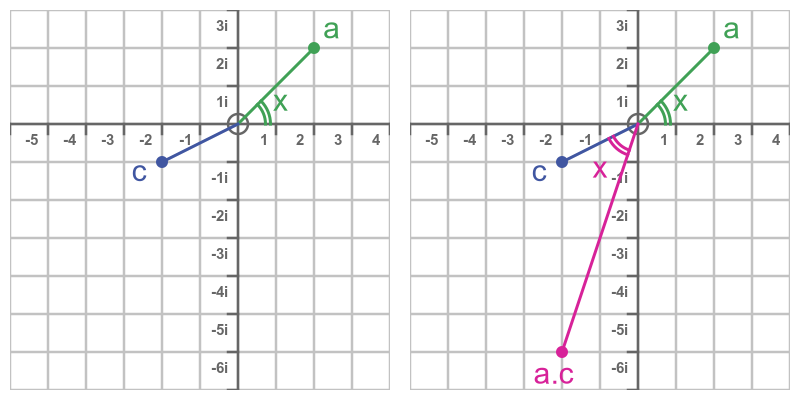
The right-hand diagram shows the product a.c. This time c is rotated by the same angle x to give the product a.c.
Adding complex numbers vs adding vectors
We would like to understand what it is about complex numbers that make multiplication behave this way. We will start with a slight aside, looking at complex number addition vs vector addition.
This vector diagram shows what happens when we add the two vectors:
- a, the vector (3, 2)
- b, the vector (1, 4)
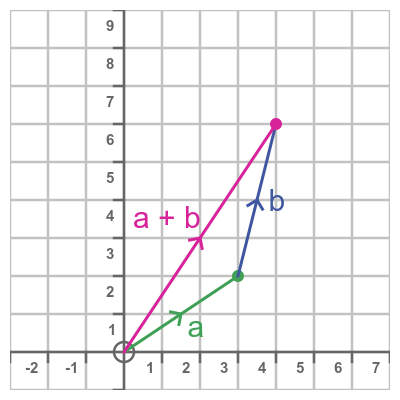
We simply add b to the end of a, so the sum is (4, 6).
This image shows what happens when we add the two complex numbers on an Argand diagram:
- a = 3+ 2i
- b = 1 + 4i:
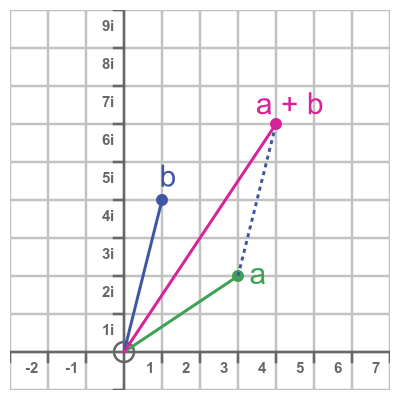
This works in a similar way. We add the real parts and the imaginary parts separately, in much the same way that we added the x and y components of the two vectors together in the previous example. And the result is the same, 4 + 6i, which is equivalent to the vector (4, 6).
Multiplying complex numbers vs multiplying vectors
We will now look at complex multiplication in more detail. We will use two general complex numbers:
- d = s + t i
- e = u + v i
If we multiply out d and e we get this:

Since i squared is -1, we can simplify this:

We can't directly compare multiplying complex numbers with multiplying vectors, because there is no way of multiplying two 2-vectors to give another 2-vector as a result. Vectors only support dot products (which produce a scalar value) or cross products (which only apply to 3-vectors, not 2-vectors).
However, if we premultiply a 2-vector (e in this case) by a 2 by 2 matrix, we get a 2-vector:
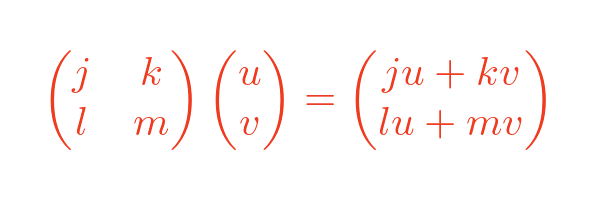
Notice that the resulting vector has a similar form to the result of the complex number multiplications. Each part of the vector consists of a term in u and a term in v. If we choose particular values for j, k, l and m we will get a vector that looks exactly like the previous complex number. Like this:

This tells us that there is a relationship between complex number multiplication and vector multiplication. These two calculations give the same result (in complex or vector form)
- Multiplying two complex numbers d and e.
- Premultiplying the vector e by a special matrix containing the values in d.
Let's try this with a = 2 + 2i and b = 1 + 3i from the first example at the start of the article. We will form a matrix from the values in a, and a vector from b, and multiply them together:
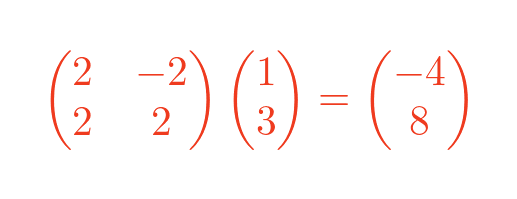
This, of course, gives the same result as the complex multiplication, which was -4 + 8i.
Expressing the matrix in polar form
To understand the effect of the matrix, it is useful to express the vector d in polar form:
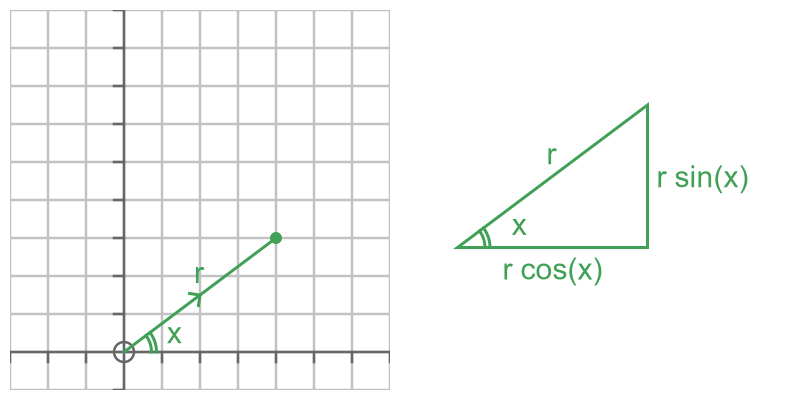
The vector d has length r and makes an angle x with the x-axis. So it can be expressed in polar form as:

We can apply these values for s and t to the previous matrix:

So we now know that multiplying two complex numbers d and e is equivalent to premultiplying the vector e by a special matrix made from the length and angle of d.
Identifying the matrix
So what is this special matrix? Well to help us find out, we can extract the common factor r into a separate matrix, like this:

You can easily verify this by multiplying the two matrices together.
But how did we know to do this in the first place? It is because the right-hand matrix (using r) is a well-known transformation. It scales the 2d plane by a factor r.
The left-hand matrix (using x) is also a well-known transformation. It rotates the 2d plane by angle x. counterclockwise, about the origin.
So this tells us that multiplying two complex numbers d and e is equivalent to scaling the vector e by r and then rotating it by x, where r and x are the polar coordinates of d.
This explains why complex multiplication causes rotation.
Complex numbers have many properties and have uses in many branches of maths and science. One of those properties is the ability to easily and intuitively represent scaling and rotation.
Related articles
- Imaginary and complex numbers
- Complex number arithmetic
- Argand diagrams
- Modulus-argument form of complex numbers
- De Moivre's theorem
- i to the power i
- Euler's formula and its proof
- Complex powers and roots of complex numbers
- Semiprocal numbers - z to the power i
- Complex polynomials
- Complex number trigonometry functions
Join the GraphicMaths Newsletter
Sign up using this form to receive an email when new content is added to the graphpicmaths or pythoninformer websites:

Popular tags
adder adjacency matrix alu and gate angle answers area argand diagram binary maths cardioid cartesian equation chain rule chord circle cofactor combinations complex modulus complex numbers complex polygon complex power complex root cosh cosine cosine rule countable cpu cube decagon demorgans law derivative determinant diagonal directrix dodecagon e eigenvalue eigenvector ellipse equilateral triangle erf function euclid euler eulers formula eulers identity exercises exponent exponential exterior angle first principles flip-flop focus gabriels horn galileo gamma function gaussian distribution gradient graph hendecagon heptagon heron hexagon hilbert horizontal hyperbola hyperbolic function hyperbolic functions infinity integration integration by parts integration by substitution interior angle inverse function inverse hyperbolic function inverse matrix irrational irrational number irregular polygon isomorphic graph isosceles trapezium isosceles triangle kite koch curve l system lhopitals rule limit line integral locus logarithm maclaurin series major axis matrix matrix algebra mean minor axis n choose r nand gate net newton raphson method nonagon nor gate normal normal distribution not gate octagon or gate parabola parallelogram parametric equation pentagon perimeter permutation matrix permutations pi pi function polar coordinates polynomial power probability probability distribution product rule proof pythagoras proof quadrilateral questions quotient rule radians radius rectangle regular polygon rhombus root sech segment set set-reset flip-flop simpsons rule sine sine rule sinh slope sloping lines solving equations solving triangles square square root squeeze theorem standard curves standard deviation star polygon statistics straight line graphs surface of revolution symmetry tangent tanh transformation transformations translation trapezium triangle turtle graphics uncountable variance vertical volume volume of revolution xnor gate xor gate
